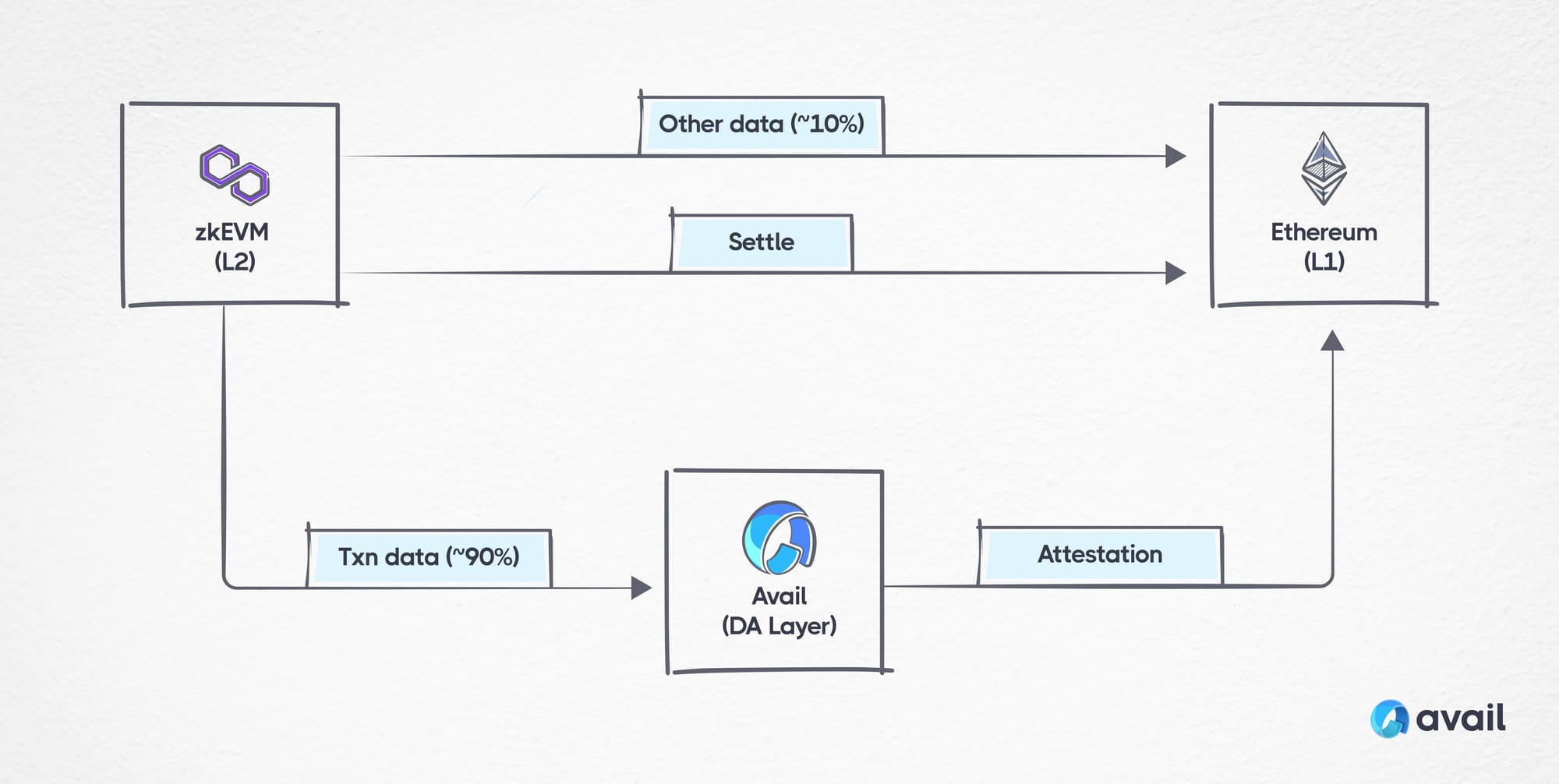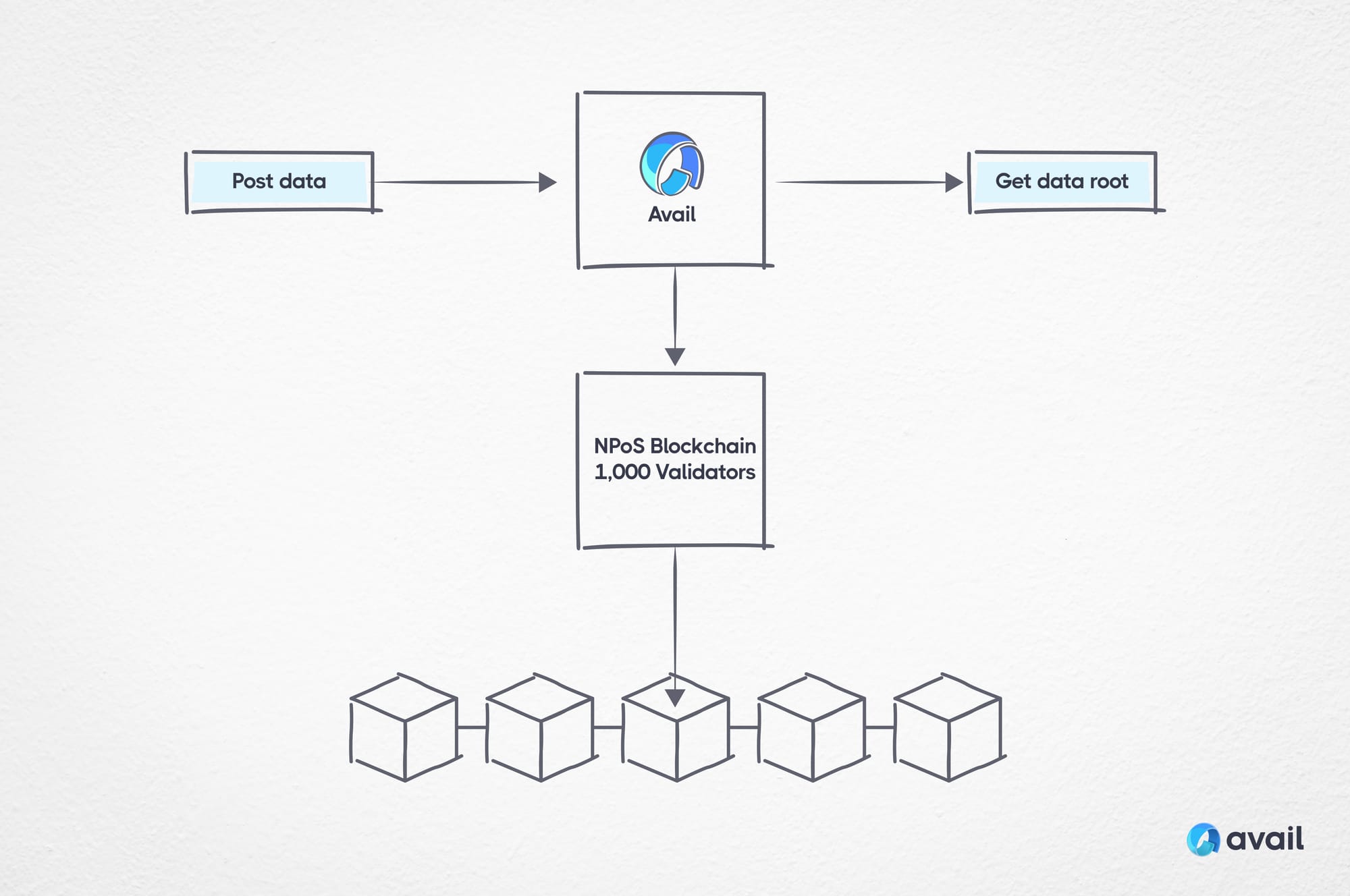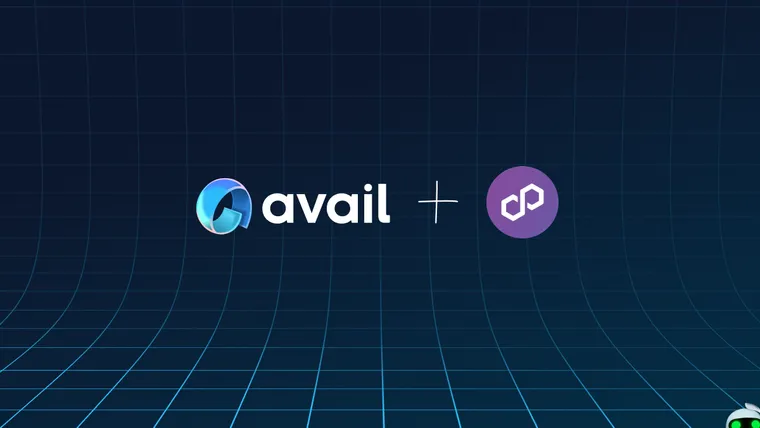TL;DR
- zkEVM Validiums can lower Ethereum gas fees by up to 90%.
- Avail provides secure, low-cost and decentralized block space for data availability.
- Validation for zkEVM Validiums is achieved through smart contracts on Ethereum.
- Avail was spun off from Polygon Labs earlier this year.
- Avail is on the road to mainnet.
zkEVM Validium with Avail
The zkEVM Validium is a new construct that offers developers substantially lower transaction costs for zkEVM blockchains. It does this by posting transaction data to Avail’s purpose-built data availability blockchain instead of Ethereum.
The Avail blockchain has been engineered as a specialized data availability layer from the ground up. The Avail blockchain produces and secures raw block-space that other blockchains, like zkEVM chains, can leverage for their data-availability needs.
Building a zkEVM Validium using the Polygon CDK enables you to benefit from seamless interoperability and shared liquidity within the Polygon ecosystem and settle on Ethereum using future-proof ZK technology with substantially lower transaction costs.
How do zkEVM chains manage data availability today?
zkEVM chains built with Polygon CDK use Ethereum as their default data availability layer. Transactions are ordered, validated and posted to Ethereum in batches as calldata. Transacting on Ethereum is expensive, so deciding what data your zkEVM chain will post to Ethereum is an important consideration to make when building a new zkEVM chain. Up to 90% of the costs paid to post data to Ethereum by zkEVM chains today is for transaction data.

While Ethereum is used as a data availability layer by a number of blockchains, it was not meant to be used as a DA solution. This is one of the main reasons why the cost of using Ethereum as a DA layer is relatively high when compared to using a purpose-built DA blockchain like Avail.
What is the zkEVM Validium?
The zkEVM Validium is an adapted version of Polygon’s zkEVM node and contracts that uses Avail to manage data availability instead of Ethereum. This provides new and existing teams building zkEVM chains with a simplified option to manage DA on Avail’s blockchain and benefit from the improved economics. The zkEVM Validium reduces the amount of data that needs to be posted to Ethereum by up to 90%, significantly lowering the chain’s operating costs and enabling much cheaper transaction fees for end users.

What is Avail?
Avail DA is a data availability focused blockchain. Its blocks are designed to provide secure, decentralized and low-cost blockspace for the data availability needs of other blockchains like zkEVM chains. Avail has also been built with future-proof ZK technology, using validity proofs to verify that data posted to the Avail network is secure and available.
Avail’s nominated proof-of-stake blockchain network was built using the Polkadot SDK to reduce the risk of validator centralization, and to support up to 1,000 external validators. Data is published on Avail’s blocks by other blockchains and validated by the Avail network, but not executed.
Avail began as a project inside Polygon in 2020 and became a separate entity in 2023. The team is led by Polygon’s co-founder Anurag Arjun and former Polygon research lead Prabal Banerjee, and is set up to provide an industry leading data availability solution.
How does Avail work?
Data is posted to the Avail blockchain where it gets extended through erasure encoding. This process adds redundancy to the data managed by Avail and makes it harder for nodes to suppress any data. Avail then generates two attestations for validation and to ensure the data has a footprint in the block’s header. One being KZG polynomial commitments of the submitted data and the other, the ‘data root’ which is the root of the Merkle tree whose leaves are the data blobs submitted.
Once a supermajority of the Avail validators have agreed on a block, it is finalized using the GRANDPA finality gadget. At this point, the data availability is guaranteed by Avail. The data root from the finalized block can then be used to show proof of inclusion of posted data within a finalized Avail block.

How does the zkEVM Validium work?
Like today, the sequencer creates batches of transactions and right before the batch is closed, the RLP-encoded transaction data for the batch is sent to the Avail blockchain.
Here the data goes through Avail’s standard process including erasure encoding and commitment generation. Once a supermajority of Avail validators have agreed on a block, it’s finalized. The data is guaranteed by the Avail blockchain network at this point, providing a soft confirmation. The DA inclusion proof which consists of a block number, leaf index, tree width and proof is sent back to the sequencer.
The data root is sent from Avail to Ethereum via the Vector data attestation bridge. This enables the Validium sequencer to verify on Ethereum that Avail’s validators have reached consensus on the data’s availability. Once the sequence sender receives confirmation that the data root for a given batch of transactions has been successfully posted to Ethereum, the batch can be submitted. The sequencer submits the inclusion proof to Ethereum.
Below is a simplified diagram showing how the zkEVM Validium works, for a more detailed view please check out the docs.

zkEVM Chain vs zkEVM Validium
The below table highlights key differences between zkEVM chains and zkEVM Validiums. The main difference being that transaction data is managed off-chain for the zkEVM Validium by the Avail blockchain, inheriting the Avail network’s security.
Build a zkEVM Validium Today
Polygon CDK provides developers with a way to build highly customizable, scalable and interoperable layer 2 blockchains that benefit from Polygon’s bleeding edge ZK technology. The zkEVM Validium enables you to do all of this while simultaneously lowering transaction costs even more.
Teams can begin building and testing their zkEVM Validium Chains with the Validium node repo and contracts today. If you have any questions you can join the Avail Forum or Discord. To learn more about Avail check out the Avail Documentation and follow us on X.


